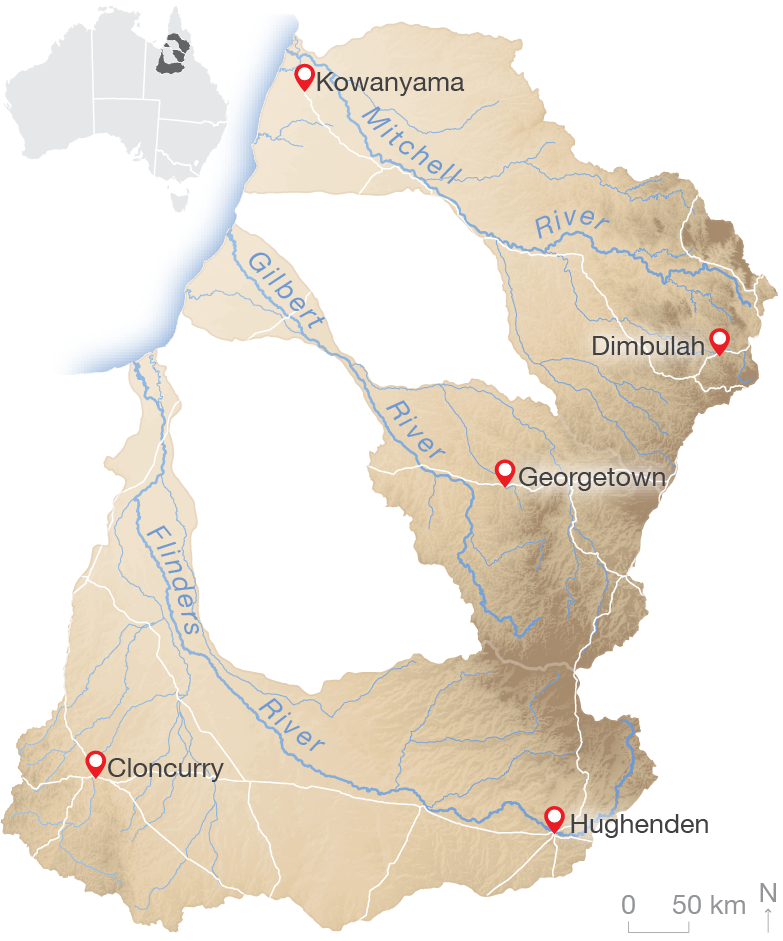The Mitchell, Gilbert and Flinders rivers flow into the southern Gulf of Carpentaria, supporting healthy ecosystems and nationally significant wetlands as well as important recreational and commercial fisheries. Banana prawns, barramundi and other important fishery species use estuarine ecosystems at different points throughout their life cycle. The Queensland State Government has also identified these river systems as catchments where irrigated agriculture is already occurring or likely to occur.
Specifically, water managers needed to know which flow characteristics of the rivers earmarked for future development are most important for the region’s plants and animals so they can make informed management decisions. This project has provided important new information about why freshwater flows in the Gulf estuaries and floodplains are essential for banana prawn and barramundi fisheries and the broader estuarine ecosystem, and modelled the potential scale of the impact of water extraction on the fisheries.
This project:

Location of the three study rivers in north Queensland.
River flows in the Gulf of Carpentaria are an essential part of the lifecycle of numerous important fishery species in the Gulf, particularly prawns and barramundi. Hub research has built on long-term partnerships with these fisheries and used a combination of on-water sampling, data analysis and satellite imagery to improve understanding of the possible impacts of water extraction from Gulf rivers on these fisheries.
Hub research in the Gulf of Carpentaria aims to support sustainable development in the region. This includes research to inform water allocation planners and floodplain managers about the potential impacts of changes in flow on fisheries, migratory birds and biodiversity. Rivers that flow into the southern Gulf of Carpentaria are home to high-value ecosystems and support important recreational and commercial fisheries. With increasing development in the region, more information is needed to understand how future water development will impact on the health and productivity of floodplains and coastal areas.
The Northern Australia Environmental Resources Hub addressed key research questions to come up with practical, on-ground solutions to some of the north’s most complex environmental challenges. A transdisciplinary research approach has been at the heart of the hub. Integrating key research users – policy-makers and land managers including Traditional Owners and ranger groups – into the co-design of research projects has led to rapid uptake of research outcomes into land management practices and decision-making. The hub has produced this wrap-up video outlining these impacts from the perspectives of research users.
Did you know Gulf of Carpentaria coasts are critically important habitat for migratory shorebirds? These birds fly to Australia from as far away as Alaska every year, and rely on the worms, crabs, clams and other food of the Gulf mudflats and sandflats to fatten up for their journey. This collaboration between Carpentaria Land Council Aboriginal Corporation and Griffith University is showing just how important the Gulf is for these long-distance fliers.
Flows from rivers into the Gulf of Carpentaria contain nutrients that support the growth and reproduction of important fisheries species like banana prawns and barramundi. This project investigated the importance of three rivers – the Mitchell, Flinders and Gilbert – to Gulf fisheries.
Mike Venarsky presents at the December 2018 DES (Qld) Workshop about the community-level migration patterns of fish in the Mitchell River and some of its tributaries.
David Crook discusses how otolith chemistry can help explain and document fish life history.
Glenn McGregor presents on how environmental assessments contribute to the evaluation of Water Plans in Queensland at a DES Workshop from December 2018.
Jonathan Marshall explains how paleo-ecological tracers can help understand past ecosystem variability to predict and manage now and into the future.
The project was led by Professor Michele Burford at Griffith University, with Associate Professor Jim Smart and Professor Stuart Bunn from Griffith University leading sub-projects.
The project leaders were assisted by researchers from Griffith University, CSIRO, Queensland Department of Agriculture and Fisheries, Charles Darwin University and the Northern Territory Department of Primary Industry and Resources.
This project was completed in September 2021.
Contact
Michele Burford, Griffith University
m.burford@griffith.edu.au
(07) 3735 6723